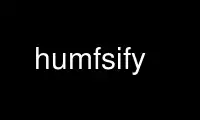
This is the command humfsify that can be run in the OnWorks free hosting provider using one of our multiple free online workstations such as Ubuntu Online, Fedora Online, Windows online emulator or MAC OS online emulator
PROGRAM:
NAME
humfsify — convert a directory to the format needed by the UML humfs file system
SYNOPSIS
humfsify [user] [group] [size]
DESCRIPTION
This manual page documents briefly the humfsify command.
This manual page was written for the Debian GNU/Linux distribution because the original
program does not have a manual page. Instead, it has documentation in HTML format; see
below.
humfsify is a Perl script necessary to convert a directory to a format expected by the UML
humfs file system.
HISTORY
UMLFS was born with the idea to substitute the Hostfs implementation with a proper one for
the UML purpose: when you manage files with Hostfs within UML you need to work with two
different permission layers (the Host one and the UML one), which have different ideas of
ownerships.
This becomes evident when you need to create a file as a non-root user on UML: you first
need to interact with the UML file system implementation, and then with the host side.
The result of a file creation on a mounted hostfs file system is not what you expected:
you can see that the file permissions refer to the Host side user rather than the UML
creator.
The Host side user is to be intended as the UML instance launcher, meanwhile the UML side
user is the one you used to log in the UML instance.
You can encounter a more-critical problem when creating a device node, operation that
usually requires root privileges: you used a common user to launch the UML and, since the
operation is done on the Host, it fails, even if you logged in as root.
Thus you need a set of tools which requires to bypass the Hostfs permission checks on the
Host side: this is done by separating the file permissions and the ownership from the
host's files. This is the concept behind the HumFs and its humfsify implementation.
ARGUMENTS
user This is the user that needs to 'convert' a directory to the UML file system to
use UML. This is the host user who will be using this filesystem from within
UML. It may be specified as either a user name or a numeric user id.
group This is the group which your UML user belongs to. This may be either a group
name or a numeric group id
size This is the size of the file system as seen within the UML instance. It must be
expressed in Gigabytes ("G"), Megabytes ("M"), or KiloBytes ("K").
EXAMPLES
Create a directory on the host and mount it with humfsify
host% mkdir your-humfs-dir
host% cd humfs-dir
Within this directory create a new one where you would like to have a UML-like hierarchy,
i.e. you can loop-mount an UML rootfs
host% mkdir dir-to-be-humsified
host# mount -o loop rootfs /mnt
host% cp -a /mnt dir-to-be-humsified/data
host# humfsify user group 512M
Then verify it on UML and mount the humfsified directory:
UML# mount none /your-uml-host -t humfs -o
where '/your-uml-mount-point' is the mount point on UML for the humfsified file system,
and .../dir-to-be-humfsified is the humfsified directory in the example above. The '-t'
mount option specifies that the file system is to be mounted as 'humfs'.
Use humfsify online using onworks.net services
